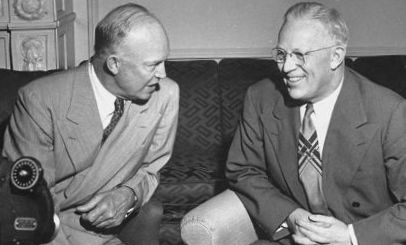Authors:
Historic Era: Era 9: Postwar United States (1945 to early 1970s)
Historic Theme:
Subject:
October 2020 | Volume 65, Issue 6


Authors:
Historic Era: Era 9: Postwar United States (1945 to early 1970s)
Historic Theme:
Subject:
October 2020 | Volume 65, Issue 6
Editor's Note: Susan Eisenhower, a consultant and expert on international policy and security, has recently published How Ike Led: The Principles Behind Eisenhower's Biggest Decisions, based on years of research into how her grandfather made his biggest decisions by relying on a core set of principles and gave our country eight years of peace and prosperity. She is also Chairman Emeritus of the Eisenhower Institute.
Dwight Eisenhower felt that a key role for a head of state was to unify the country, and after he became president in 1953, he made national unity arguably his highest priority for the next eight years. Ike was utterly dedicated to the oath he had taken to defend the Constitution, the pledge he first made as a young cadet at West Point.
There is no greater evidence for President Eisenhower’s approach to constitutionalism than his court appointments. Ike did not believe that the political process should taint the courts, as an independent branch of government. With an idealism that seems almost quaint in today’s partisan climate, he felt there should be a balance on the Supreme Court between Democrats and Republicans. When Ike assumed the presidency, eight of the nine Associate Justices were Democrats. During his two-term presidency, he appointed five judges to the Supreme Court with widely different viewpoints.
As Ike’s Attorney General Herbert Brownell later observed, “The president believed and acted upon the belief that the Supreme Court’s membership should represent diverse ideological points of view.” He believed this would foster public confidence in the court, which is an “unelected body.”
“If the Senate should confirm only nominees with an ideology that conforms to the Senate’s prevailing ideology,” Brownell asserted, “it would be a signal that the Senate wanted the Court to decide constitutional issues not on an independent judicial basis but on a political ideological basis.”‘

There was precedent for this. Only 110 days after Harry Truman became president in 1945, Justice Owen Roberts retired leaving a vacancy on the Supreme Court. The Democrat Truman appointed Harold Hitz Burton, the Republican Senator from Ohio, to balance a Court whose justices had all been appointed by Franklin Roosevelt. The Senate unanimously confirmed Burton on the same day Truman appointed him in recognition of this gesture of bipartisanship.
Even before Eisenhower was elected president in 1952, challenges had been brewing to the Supreme Court’s ruling in Plessy v. Ferguson which had established the principle of “separate but equal” public facilities for Whites and African-Americans. Decades after